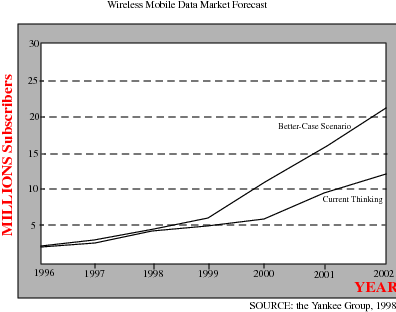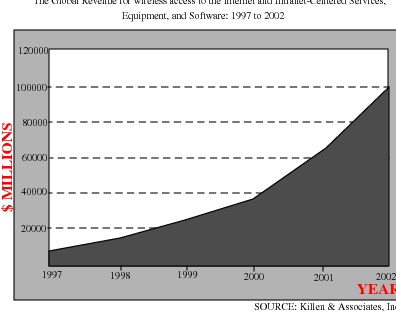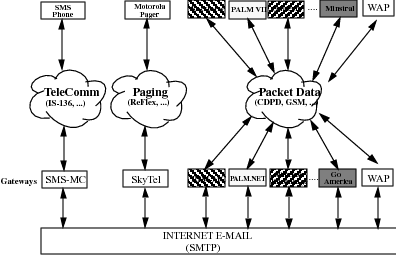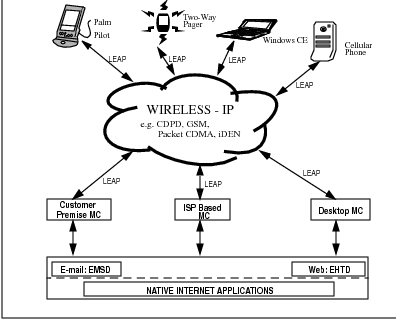The Mobile Messaging Industry
The Mobile Messaging Industry
| Document Number: | PLPC-100001 [ .bib ] |
| Version: | 0.3 |
| Dated: | August 4, 2000 |
| Group: | LEAP |
| Primary URL: | http://www.freeprotocols.org/PLPC/100001 |
| Federated Publications: | ByTopic -- ByContent |
| AccessPage Revision: | This AccessPage was produced on May 08, 2013 at 23:52 PDT (-0700) |
| Author(s): | Andrew Hammoude, Mohsen BANAN |
| Organization: | Free Protocols Foundation |
AVAILABLE FORMATS
- PDF: -- 160K -- Provides the document in Portable Document Format.
- PS: -- 1.6M -- Provides the document in Postscript format for printing.
- HTML: -- 192K -- Displays the document as a web page.
SHORT
DESCRIPTION
This article provides an overview of the Mobile Messaging industry, and a description of the essential factors that are required for its long term success and growth.
The Mobile Messaging Industry
Mohsen Banan
http://mohsen.banan.1.byname.net/ContactMe
First Published: August 4, 2000
Last Updated: August 10, 2000
Copyright ©2000 Mohsen Banan
copies of this manual provided the copyright notice and
this permission notice are preserved on all copies.
A Component of The LEAP Manifesto
This article is one of a series of articles describing various aspects of the Mobile Messaging industry and the Lightweight &
Efficient Application Protocols (LEAP) protocols. For the complete collection of articles see The LEAP Manifesto [1], available
at
http://www.LeapForum.org/LEAP/Manifesto/roadMap/index.html. The LEAP Manifesto is also available at the Free
Protocols Foundation website at
http://www.FreeProtocols.org/LEAP/Manifesto/roadMap/index.html.
Contents
2 The Next Big Thing: Mobile Messaging
2.1 The Mobile Messaging End-User
3 Comparison to Paging
4 Timeliness of Mobile Messaging
5 Market Forecasts
6 Current Status of the Mobile Messaging Industry
7 Differences among Mobile Messaging Providers
8 The Fundamental Obstacle: Lack of Inter-Operability
9 The Key Enabling Requirement: A Standard Protocol
10 Protocol Requirements
List of Figures
2 Global Wireless Internet Revenues
3 Existing Mobile Messaging Systems
4 Open Mobile Messaging
List of Tables
1 Introduction
In recent years we have seen dramatic and rapid changes in the nature of interpersonal communications. As little as ten years ago, land-line telephone was the dominant medium for quick-turnaround, informal, interpersonal communication. In less than a decade, two new technologies have radically changed the character of person-to-person communications. The first of these technologies is e-mail. The second is the mobile telephone.
Ten years ago, these technologies were highly specialized communications capabilities, known to and used by a relatively small number of people. In just the last decade, usage of these technologies has grown explosively, propelling them from relative obscurity to mainstream acceptance among the population at large. E-mail and cell phones have been enthusiastically embraced by the public and by businesses, and have now become an everyday, indispensable aspect of modern life.
2 The Next Big Thing: Mobile Messaging
E-mail and cell phones each provide obvious and significant advantages over traditional land-line telephone communication, and this accounts for their extraordinary success. Among other things, e-mail provides the ability to conduct interpersonal communications on an asynchronous basis, and also provides the qualitative advantages of the written, over the spoken, word. And cell phones provide the self-evident advantages of mobile, real-time voice communications.
Individually, the major advantage of each of these two technologies is not shared by the other. The correct combination of the two technologies, however, can provide the major advantages of both. We refer to this combined technology as Mobile Messaging. Formally, we define Mobile Messaging as the ability to send and receive e-mail messages from a mobile, hand-held or hand-carried device. This capability is also sometimes referred to as Wireless Messaging, or Mobile E-mail.
The relationship between Mobile Messaging and conventional e-mail is somewhat similar to that between mobile phones and land-line phones: in each case mobility is being brought to a pre-existing, fixed-location, communications technology.
Mobile Messaging adds another component to a person’s array of interpersonal communication options. Along with other enduring communications media such as conventional telephone and e-mail, voice mail, Fax etc., it provides a unique set of advantages to the user.
2.1 The Mobile Messaging End-User
Usage of Mobile Messaging among end-users is expected to evolve in a similar way to the historical evolution of One-Way Paging. As was the case with One-Way Paging, early usage of Mobile Messaging is expected to be mostly among specialized users, such as emergency service professionals and field service professionals.
Usage is then expected to spread quickly to more general users such as mobile professionals, soccer moms, and so on. Some examples of typical early specialized, and later generalized, users are provide in Table 1.
| Early: Specialized | Later: Generalized
|
| Medical Industry | Mobile Professionals |
| Public Safety | Apartment Managers |
| Emergency Professionals | Expectant Fathers |
| Drug Dealers | Rich Brats (90210) |
| Field Service Technicians | Soccer Moms |
| Financial Industry | |
3 Comparison to Paging
Modern desktop e-mail applications typically expect a fast Internet connection, and always expect a large amount of disk space in order to store e-mail messages of arbitrary size. The general trend in desktop e-mail has been towards being able to exchange ever larger and more complex messages, including graphics, sound, and video.
The paging network resides at the other end of the messaging spectrum. The data transfer capability of paging has progressed from purely numeric messages to short alphanumeric messages, but still remains very limited. The first paging systems were one-way only, but recently some proprietary two-way paging systems have become available, in which the paging device can both send and receive messages.
In terms of data transfer capabilities, Mobile Messaging occupies an intermediate role between conventional desktop e-mail and two-way paging. Table 2 compares the basic characteristics of desktop e-mail, paging, and Mobile Messaging. Note that e-mail and paging each have critical advantages that the other does not. For the transfer of ordinary (i.e. not excessively long) messages, however, Mobile Messaging provides all the principal advantages of both desktop e-mail and paging.
| Desktop | Traditional | Mobile | |
| Paging | Messaging | ||
| Message Structures | Yes | No | Yes |
| (From:, Subject:, Date:) | |||
| Mainstream & Open | Yes | No | Yes |
| (Any device works with any message center) | |||
| Intranet Provider Supplied Account (generally) | Yes | No | Yes |
| Service Provider (ISP) Supplied Account | Yes | Yes | Yes |
| Mobile & Wearable | No | Yes | Yes |
| Urgent/Pushed Message Delivery | No | Yes | Yes |
| Access Through Ordinary Telephone | No | Yes | Yes |
| Good For Long Messages | Yes | No | No |
4 Timeliness of Mobile Messaging
All the basic technological and cultural requirements are now in place to allow the Mobile Messaging industry to come into existence and reach its full potential. The basic requirements for widespread Mobile Messaging are:
- Wireless Networks: must be reliable, widespread and affordable
- Wireless Modems: must be available in mobility-enabling form factors, and affordable
- Mobile Devices: must be available and affordable
- End-Users: must be ready to accept Mobile Messaging capability
All of these pre-requisites now exist. Wireless networks are widely established and growing. Wireless modems are now fully capable of supporting Mobile Messaging. A multiplicity of end-user devices suitable for Mobile Messaging exist, such as PalmPilot, Windows CE devices and pagers.
And finally, the cultural climate is ripe: end-users are familiar with and have accepted the benefits of e-mail and cell phones. The step to acceptance of mobile e-mail is a very short one.
5 Market Forecasts
The LEAP Manifesto is not a business plan, and our concern is not the making of business profit. Instead, throughout the series of articles that make up the manifesto, we are concerned with what is required to create and build a healthy and vigorous Mobile Messaging industry, that will bring the greatest benefits to the industry participants and to the consumer. For this reason, quantitative market forecasts are not of any great relevance.
For those interested in such matters, however, we can say that the market for Mobile Messaging is extremely large. Market surveys repeatedly show that electronic messaging is the dominant application for both local area networks and wide area networks. Intranet operators and Service Providers repeatedly cite e-mail as the number one user requirement. Similarly, in the wireless arena, there is general consensus that Mobile Messaging is the primary application for wide area wireless data networks.
With regard to the actual size of the market: nobody knows. The Mobile Messaging industry is extremely complex, from both a technological and a business standpoint, and any market projection is at best an order-of-magnitude estimate based on a particular set of assumptions. Nevertheless, there is certainly no shortage of market projections, and all agree that the forecast for growth of wireless data and mobile messaging is phenomenal. In the following paragraphs we provide a few example data points.
Figure ?? shows the projections of the Yankee Group for the growth in numbers of wireless and mobile data subscribers. In this figure, the thin (lower) line represents the current thinking of the Yankee Group. The thick (upper) line represents their better case forecast scenario.
In their 1998 study, the Yankee Group estimated that in 1999 there were already almost 7 million wireless and mobile data subscribers. They forecast that by the year 2002 this number would increase to over 21 million subscribers, using numerous independent networks. Every one of those subscribers is likely to use Mobile Messaging in some form. The Yankee Group also forecast that sales of two-way pagers will reach 5 million in 2000, 24 million in 2001, and 54 million in 2003.
A recent study by Killen & Associates estimates that the North American market alone for carrier services, equipment and software for wireless internet applications will jump from $2.7 billion in 1999 to $37.5 billion by 2002. They estimate that the global revenue for wireless access to the Internet and Intranet centered services, equipment and software will jump from $2.2 billion in 1999 to $10.0 billion by 2002.
Figure ?? shows the projections of Killen & Associates for the growth of global revenue for wireless access to the Internet and Intranet centered services, equipment and software.
Whichever set of numbers you choose to believe, it is clear that the Mobile Messaging industry is destined for a spectacular future. The consequences of widespread wireless data communications capability are going to be enormous, in technological, cultural, and economic terms.
6 Current Status of the Mobile Messaging Industry
Despite its technological timeliness and enormous potential market size, the Mobile Messaging industry has yet to be realized in any meaningful way.
Numerous vendors claim to have some sort of Mobile Messaging product and service in place. Since most wireless networks have already converged towards IP, it is often fairly easy to get short messages to users over wireless networks, using simple custom protocols. These various systems all claim to be open; however, none of them work together, and they cannot make use of each other’s assets. The result of this is that the Mobile Messaging arena is populated by various closed, non-interoperating products and services, and is currently dominated by a relatively small number of closed systems. None of these closed systems has a long-term future.
Most Mobile Messaging services are built on existing infrastructures and capabilities, and are available through paging and cellular phone companies as an extension of current services. However, building wireless messaging capability with protocols such as ReFLEX and IS-136 is at best a stopgap measure, because of the inherent size and structure limitations of those protocols. Moreover, these protocols are not IP based, and cannot benefit fully from the coming IP convergence.
Research In Motion (RIM; www.rim.net) has created an excellent, though closed, Mobile Messaging solution with its Blackberry(tm) mobile e-mail system. While RIM is currently leading the industry with its combined product and service offering, other manufacturers and service providers are moving quickly to catch up.
7 Differences among Mobile Messaging Providers
In short, the Mobile Messaging industry is seeing general agreement on the general concept of e-mail, but a complete lack of agreement or standardization on common technologies and protocols. Mobile Messaging providers are distinguished not only by differences in their services and products, but also by differences in:
- Physical networks and methods of data transfer
- Interface software
- Point-to-point routing software
- End-to-end and data reliability software
This high degree of heterogeneity and lack of interoperability within the industry acts to constrain its growth. Users are compelled to invest in one of several closed solutions from a particular group of service providers, and must then remain committed to that group of service providers.
Growth of the industry would be greatly enhanced if users were able to invest in a set of Mobile Messaging hardware products, then move freely from one service provider to another. This reduces the capital investment risk to the purchaser, thereby facilitating and encouraging his investment. Also, by decoupling the various components of a Mobile Messaging solution from one another, competition within each component is encouraged, resulting in better products and services. All of this serves to increase the vitality and growth rate of the industry as a whole.
8 The Fundamental Obstacle: Lack of Inter-Operability
Existing implementations of Mobile Messaging are based on closed and proprietary systems, services and devices. End-to-end transmission of delivery of messages requires smooth interoperability among networks, service providers, and devices. This is accomplished by means of protocols, which define the required interoperability. However, today’s Mobile Messaging solutions are based on protocols which are closed and proprietary to the networks and/or service providers, and which cannot interoperate with other networks. Therefore the message centers and devices for a particular Mobile Messaging solution do not interoperate with those for a different solution and/or network.
While RIM’s Blackberry(tm) service provides a model for wireless messaging, its closed design inhibits its adoption by the industry at large.
The current status of the industry is illustrated in Figure 3, which shows the interoperability relationships among various systems, networks, and devices. As the figure shows, each Mobile Messaging system is closed and unable to interoperate with the other systems.
9 The Key Enabling Requirement: A Standard Protocol
This lack of standardization within the industry inhibits its growth. In order for the industry to reach its potential, there must be complete interoperability among all components of a complete Mobile Messaging solution. All of the current and future wireless networks must interoperate easily, like the Internet itself, as a single network.
In order for this to happen, the Mobile Messaging industry must adopt a single, standard set of open protocols. Ultimately, network industries are based on protocols, not on specific products or services. The key enabling and driving force is the underlying protocol. Until a single open standard is adopted, growth of the Mobile Messaging industry will remain inhibited.
10 Protocol Requirements
The correct protocol will define a universal set of rules which provide an efficient, high-reliability, end-to-end data path for Mobile Messaging.
Existing Internet e-mail protocols are not adequate for Mobile Messaging. They are not bandwidth efficient, nor do they properly support the ”push” model for delivery of time-critical messages. In the “push” model, the message is delivered directly and immediately to the recipient, like a pager message. In the case of existing Internet e-mail protocols, messages must wait on a server until they are picked up or “pulled” by an explicit action on the part of the recipient.
At Layer 3, it is clear that all data networks, both wired and wireless, are now converging on Internet Protocol (IP). The importance of Internet access ensures that this convergence will continue. Therefore a basic requirement of the protocol is that it define message transmission over wireless IP.
In addition, the protocols must adequately address the particular requirements of Mobile Messaging; specifically, the need for bandwidth efficiency and battery efficiency of mobile platforms.
In order to be effective as an industry catalyst, the protocols must be open. This means several things. First and foremost, this means that they must be patent-free, so that there are no restrictions associated with use and implementation of the protocols. This also means that they must be published as Internet RFCs. RFC publication ensures unrestricted and permanent availability of the protocols. The protocols must also be maintained by public working groups, to ensure that the protocols are open to commentary and influence by any industry constituency that may be affected by them.
Based on all these requirements, it is clear that the needed set of protocols is missing. We claim that the LEAP protocols, described in detail elsewhere in The LEAP Manifesto, are the answer to this need.
The effect that the LEAP protocols will have on the Mobile Messaging industry is illustrated in Figure 4. As this figure shows, LEAP will provide complete openness of interoperability among Mobile Messaging devices, message centers, and wireless networks. This is in sharp contrast to the closed, non-interoperating model of Figure 3.
LEAP will thus have the effect of unifying the entire Mobile Messaging industry under a set of open Internet Protocol (”IP”) standards and protocols so that, in the manner of the World Wide Web, all of the Mobile Messaging networks will effectively operate as one.
References
[1] Mohsen Banan. Lightweight & Efficient Application Protocol (LEAP) Manifesto. Technical Report 108-101-01, LEAP Forum, Bellevue, WA, January 2000. Online document is available at http://www.leapforum.org/LEAP/Manifesto/completeManifesto.








